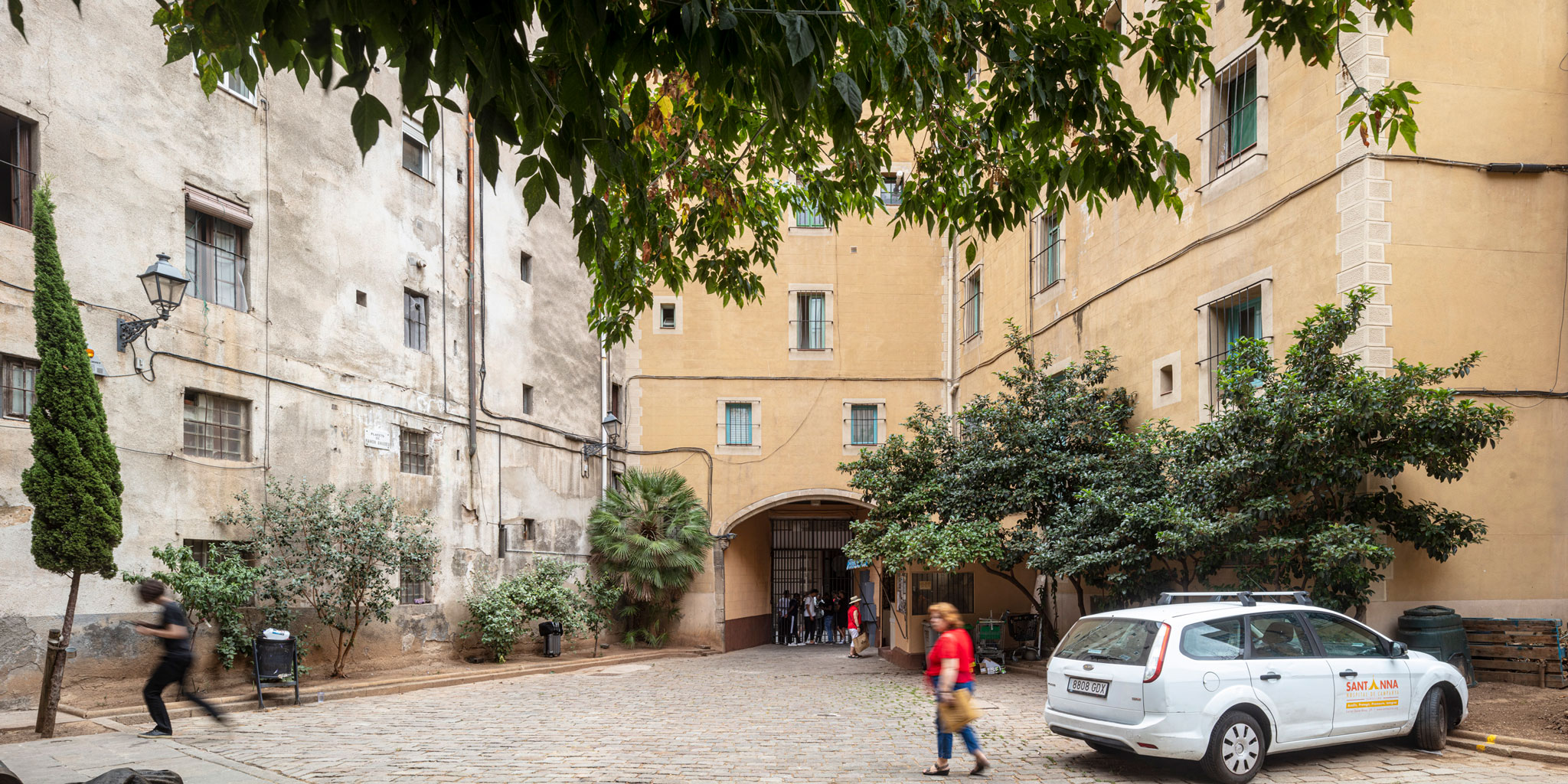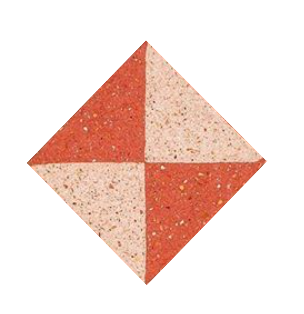Second Hand
Masters FW23

Carrer de Santa Anna, Barcelona 2023. Photo: Adrià Goula.
Semestre Autunnale 2023 / Second Hand: Urban Refettorio in Barcelona
︎︎︎ Semester FW23 Brief as pdf to download
︎︎︎ Semester FW23 Projects
Food Scarcity
“Every day we inhabit spaces made by food, unconsciously repeating actions that are as old as cities themselves.’’
(Carolyn Steel, Hungry City)
Food plays a fundamental role in the definition of the cultural identity of a place and its communities: it has the power to root people in a place, whether a public environment or a domestic one, bringing individuals together around the same table, and evoking a common sense of belonging. Sharing a meal is a powerful cultural and social gesture of our daily life, often taken for granted: it pleases our senses, providing for physical and mental wellbeing and it is characterised by its own rituality, often taking place at the same hours and in a dedicated space. Schools’ canteens, private homes’ dining rooms, local pubs and restaurants, old farmhouses: there is an immense variety of social environments and spaces built around food.
During this semester we will organize and design a space to share food among people for whom access to food is difficult. This space that we call Refettorio, should provide a beautiful and spiritual atmosphere, it will be a space that conveys calm and trust among the different individuals that probably do not know each other and share a meal together. How to make people, that do not know each other, feel together? How can the atmosphere of a space bring calm and beauty to raise the spirit?

Refettorio Ambrosiano. Photo: Angelo Dal Bò
Emotional Heritage
“It is not only people that contain the memory of a place, but buildings too are loaded with memories of the uses and lives that occupy them. The built fabric reflects social behaviour. It speaks of a way of using the ground, the sky, of a way of inhabiting. As an architect, to read the memories held in buildings and in people is to think about a future that counts on that past.”
(Flores & Prats, Emotional Heritage, Biennale di Architettura di Venezia 2023)
We propose to work in urban contexts in transformation, observing and identifying the valuable social and physical qualities embedded in the area. Being aware that not only people preserve the memory of a neighbourhood, we will discover that buildings also echo a multiplicity of uses and lives.
Our aim is to discover the emotional reality contained in existing buildings, and to test their capacity to adapt to new conditions of occupation. We will work in the city of Barcelona, where we have identified three different sites within the dense historic city centre. These three proposed areas have at the same time some analogies as well as very different characteristics: all of them are suitable for developing a program related to the scarcity of food and the building of a community around it, a project around the central space of the Refettorio, that will bring new energy to both the building and the surrounding neighbourhood. The exercise of this semester will be focused both on urban and social rehabilitation.

Plaça de Sant Agustì, Barcelona, Palm Sunday, 1932
Working Areas
When visiting the place we will be able to recognise the evolution of the site and read the traces of former centuries that are left exposed in the city. This will help us to understand that the city is an unfinished element, constantly changing to adapt and in which different historical periods are juxtaposed.
The three working areas have in common the presence of a religious building or a monastery, which is the reason to propose the design of a new Urban Refettorio around them. In two of the old monasteries, Santa Anna and Sant Agustí, there is nowadays a social kitchen serving food for free at lunch time. The different evolution of each site during the centuries has produced a very specific relationship between the original religious buildings and the city that has evolved around them. In all three cases the clerical buildings have maintained their stable appearance over time, even if they have suffered several destructions.
We will visit the sites together during our trip to Barcelona, and later distribute the areas among the class. The exercise will be developed individually at the beginning, and later in pairs.

Working Areas. Plan of Barcelona 1930-1940
1. Santa Anna
When the first monks of the Order of Canons Regular of the Holy Sepulchre arrived in Barcelona, they settled in a church located near the
Cathedral. In the 12th century they built a new monastery in the position where the present one is located, founding it near the walls to protect themselves from possible attacks (as had happened in the monastery of Sant Pau del Camp). Of this complex, the church, the cloister and the chapter house are still preserved. The church began during the Romanesque period, although the construction was prolonged during the following three centuries, already in the Gothic period. The portal through which the church was accessed since the 15th century, at number 29 Carrer de Santa Anna, is still conserved. In 1835 the whole of the annexed facilities disappeared after the ecclesiastical confiscations.
In 1875 the surrounding areas were urbanised, and as a consequence, some of the constructions belonging to the church were destroyed, but in 1881 it was named as a National Monument to avoid its demolition. After the demolition of the walls, the building known as the novitiate, located next to the current Plaça de Catalunya, was demolished. At the beginning of the Spanish Civil War the church was set on fire and the dome was destroyed. Nowadays it is possible to observe the new cimborrio made with bricks.

Ground Floor Plan of Santa Anna 1:250.
File From Arxiu Municipal Contemporni de Barcelona
File From Arxiu Municipal Contemporni de Barcelona




Santa Anna, Barcelona, 2023. Photo: Adrià Goula
2. Sant Agustì
The construction of the Ciutadella (Citadel) obliged the evacuation of the old convent of the Agustines, and as a compensation, the community was given, around 1726, a strip of land that was located between the streets of Hospital and Sant Pau, so that they could build a new convent of larger size. The first project was done by Pere Bertran, and the works started in 1728, although the project was reconsidered twenty years later by the same author, in front of the scarcity of available resources, which had caused an excessive delay of the works. The only part which is now exposed is the church, built from 1750 on, following a design by Alexandre de Retz, although the façade had been drawn by Pere Costa in 1735 , and of which only the lower half was done. The atrium made of five porticoes, which gives access to the church, is visible in the lower half of the façade. Interiorly, the church is the congregational type: a central nave of five bays with connected side chapels, a crossing with an elliptical vault and an apse which was originally rectangular (the current apse is semicircular with large Corinthian columns, and must have been done around 1839, when the temple was converted to a parish). The whole is a sober example of Catalan academic Baroque, as is apparent in the interior, whose decoration, on the other hand, was totally destroyed in the anticlerical fires of 1835 and 1936.

Ground Floor Plan of Sant Agustì 1:250.File From Arxiu Municipal Contemporni de Barcelona




Sant Agustì, Barcelona, 2023. Photo: Adrià Goula
3. Sant Pau del Camp
The monastery of Sant Pau del Camp was the first important nucleus of the Raval and a small medieval village related to the complex was located in its surroundings. The origin of the monastery is unknown, but various data show that it existed since the 10th century. It was destroyed in 1114 by the Almoravids and the church we see today dates from 1117. It was at the mercy of assailants until the construction of the second medieval wall in the 14th century, when it was then included within the city. The church has the form of a typical Greek cross with a chapel in the right gallery and a cloister to the south with an impluvium for collecting rainwater.
Once the monastery included an abbey to the west and a large vegetable garden with a cistern to the north of the church. To the east of the cloister was the chapter house and to the south the refectory with a large painting representing St. Benedict. Along the street of Huerto de San Pablo was a two-story-long building that housed the priests’ cells.
In the 1930s a school was built close to the monastery and by the end of the century, the rest of the urban block was occupied by a parking facility, that visually disconnects Carrer de Sant Pau from Carrer de les Tàpies.

Ground Floor Plan of Sant Pau del Camp 1:250.
File From Arxiu Municipal Contemporni de Barcelona
File From Arxiu Municipal Contemporni de Barcelona




Sant Pau del Camp, 2023. Photo: Adrià Goula
Urban Refettorio Programme
The proposed programme aims to reunite a variety of interrelated activities within one project, generating a place of interaction between city, people, and food. The existing buildings are given a new life, allowing them to welcome different interdependent inner worlds: Refettorio, Rifugio, Centro Diurno, Emporio, and Orti.
Refettorio Urbano aims to promote a new model, a space for hospitality and communitarian involvement, benefiting of the pivotal role of food as the key generator of this process of rebirth. Food served is the result of the transformation of the products subtracted from the frantic wasting-cycle representative of our time, becoming a symbol of action against waste and nurture for new life.
Refettorio, a place for community
Refectorium, from medieval Latin refectorium, a “place of refreshment”. From past participle of reficere “to remake, restore”, combination of re “again, anew, once more” + facere “to make, do”.
(Etymology of the word ‘‘Refectorium’’)
Arose in the Christian culture, the Refettorio is a room originally conceived as the ‘‘dining hall’’ of a monastery, a space for the communitarian meals of the clergymen who, by sharing food, strengthen a sense of social bond and collectivity.
The architecture of monasteries and convents is designed to provide the essential spaces for the rituality of daily life. From the central cloister, which is the ‘‘heart’’ of the built complex, an inner courtyard with a covered walkway (portico), one can access the four vital spaces for the nourishing of body and soul: the refectory to eat, the dormitory to sleep, the chapter house to meet and the church to pray.
In recent times a refectory can be not only associated with its clerical role, which still remains. In fact, a refectory is today also a common room within a public building (a boarding school, a military barrack, a day centre etc.) where a group of people seats together to share a meal and a moment of conviviality.
What has never changed to present days is the ancient sense of intimacy of sitting around the same table, doing the same vital action, while interacting with one another.

Refectory, La Tourette, France.
Refettorio Ambrosiano
by Massimo Bottura and Davide Rampello
Access to food should be granted to all, including those who can not provide for themselves. In a global society such as the one of today, where the wealth is so unevenly distributed, some groups of people starve while a minority of privileged individuals have a too-easy access to food, distributed by a productive system which generates surpluses and waste on a daily basis.
Refettorio Ambrosiano was born in Milan in 2015, within what used to be the former theatre of the Parrocchia di Greco, at the behest of chef Massimo Bottura and art director Davide Rampello, with the aim to salvage all the food wastes produced by Expo Milano 2015 (which today became the surpluses of Milanese supermarkets) and give them a second life, by creating respectable food for those in need, therefore both acting against food waste and for human rights. The meals are served every evening on weekdays in the main Refettorio room (which has a capacity of 96 persons) to a group of disadvantaged people, with different ages and cultural backgrounds.
It is interesting to highlight the involvement of Refettorio Ambrosiano within its wider urban context. Refettorio in fact has around it many satellite” institutions present in the neighbourhood, which guarantee services of hospitality and support to disadvantaged people, creating a strong ensemble of related / complementary activities, all with a positive social and cultural impact. Among these Rifugio Sammartini, one of the first dormitories of Milan, provides shelter to 60 people, some of which are regular guests of the Refettorio dinners, while the Centro Diurno, a place dedicated to the assistance of elderly people, offers a number of spaces for workshops, lab activities and readings.
This collaborative cohexistence of complementary entities and activities has been an inspirational model in the definition of the program of this autumn’s exercise.

Refettorio Ambrosiano, Milan

